Choosing the wrong fabric for your tracksuits? This costly mistake leads to poor performance and unhappy customers. I will guide you through the best fabric choices.
The best tracksuit fabric depends on its use. Polyester is ideal for performance due to its moisture-wicking. Cotton blends offer superior comfort for casual wear. Nylon provides durability, while mixing in spandex is essential for stretch and movement.
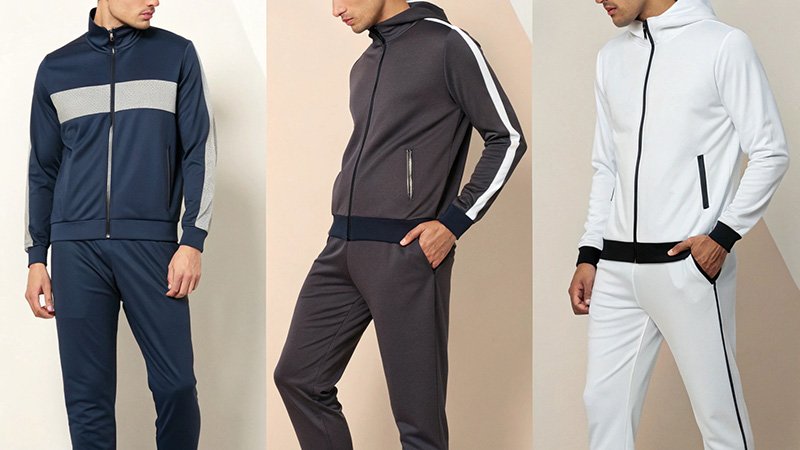
In my journey from a small sewing studio to a global manufacturing partner, I've worked with every fabric imaginable. I've learned that the feel and performance of a tracksuit all come down to the material. It's the most important choice you'll make. A great design with the wrong fabric will fail, but the right fabric can make a simple design feel premium. The options can seem endless, but they don't have to be confusing. Let's break down the best choices, one by one, so you can create a tracksuit your customers will want to live in.
Understanding Fabric Types: What are the key considerations for tracksuits?
Overwhelmed by technical fabric specs? Picking the wrong one can ruin your entire collection and disappoint customers. Focus on these three key factors to make the right choice every time.
Focus on three core factors: moisture management for intense activity, stretch for freedom of movement, and durability for long-term wear. These criteria directly impact the tracksuit's comfort, performance, and value, guiding you to the perfect fabric.
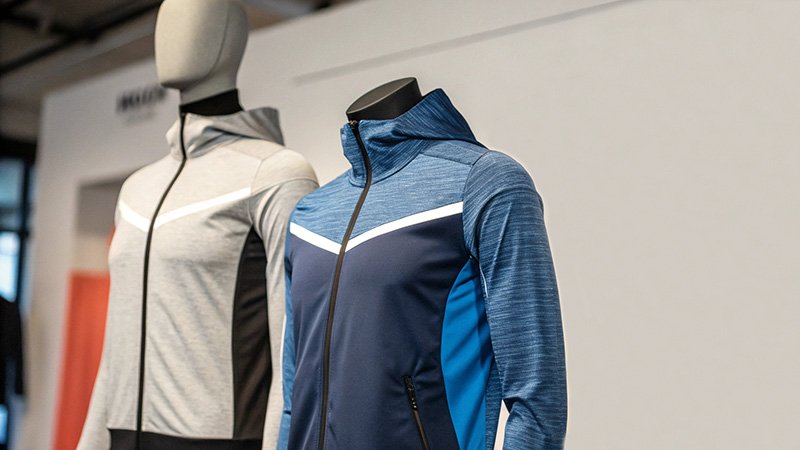
Before we even look at specific materials, we need to agree on what makes a fabric "good" for a tracksuit. Over the years, I've found that all successful designs balance the same three things. First, how does it handle sweat? a garment that gets heavy and wet is useless for performance. Second, can the wearer move freely? The fabric must stretch with the body, not restrict it. And third, will it last? Customers expect activewear to withstand tough use and frequent washing. These are not just technical details; they are the foundation of a product that people will love and trust. Getting these right is the first step to creating a best-selling tracksuit.
The Foundation of Performance
Every fabric choice starts here. Understanding these core needs will narrow down your options significantly.
| Key Consideration | Why It Matters | What to Look For |
|---|---|---|
| Moisture Management | Keeps the wearer dry and comfortable during exercise. Prevents the garment from getting heavy and cold. | "Moisture-wicking" or "quick-dry" properties. Look for synthetics like polyester or special finishes. |
| Stretch & Recovery | Allows for total freedom of movement. The fabric must return to its original shape to avoid sagging. | A blend with spandex (elastane/Lycra). Look for 4-way stretch capabilities. |
| Durability & Care | Must withstand friction and repeated washing without pilling or fading. Easy care is a must for customers. | High abrasion resistance (common in nylon). "Anti-pilling" finishes. Machine-washable instructions. |
Cotton Blends: Are they just for comfort and breathability?
You think of cotton tracksuits as purely for lounging. But pure cotton fails during a workout, absorbing sweat and feeling heavy. Modern cotton blends, however, offer the best of both worlds.
No, modern cotton blends are much more. By adding polyester for durability and spandex for stretch, these blends maintain their famous comfort while gaining performance features like better shape retention and faster drying times.
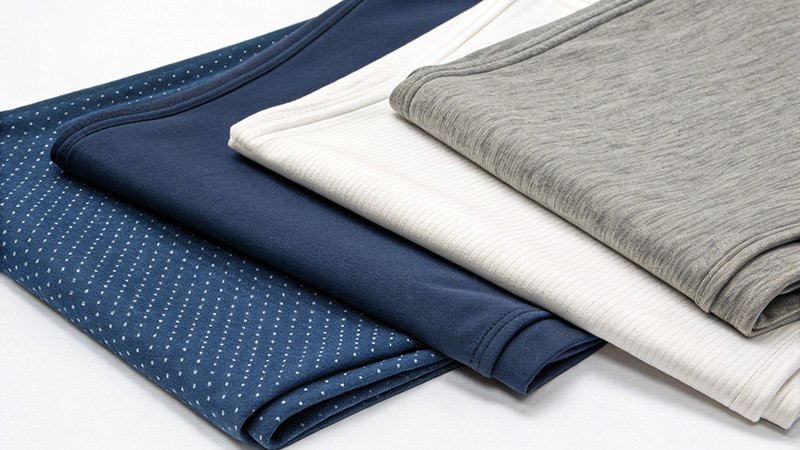
Everyone loves the feel of cotton. It's soft, it's breathable, and it feels natural against the skin. I remember making my first tracksuits almost entirely from cotton. They were incredibly comfortable for relaxing. But once you started moving, the problems appeared. Pure cotton acts like a sponge; it soaks up sweat and takes a long time to dry. That's why we almost always use cotton blends now. By mixing cotton with a synthetic fiber like polyester, you keep that wonderful softness but gain strength and moisture-wicking ability. It's a simple change that transforms a lounge garment into something much more versatile.
Modernizing a Classic
The goal is to keep the comfort of cotton while fixing its weaknesses.
- Cotton/Polyester Blend: This is the most common blend. The cotton provides softness and breathability, while the polyester adds durability, wrinkle resistance, and helps the fabric dry faster. A 60/40 or 80/20 mix is very popular.
- French Terry: This is a type of knit fabric with soft loops on the inside and a smooth surface on the outside. It's usually made from cotton or a cotton blend. It’s great at absorbing moisture, but it's heavier than a standard jersey, making it ideal for cozy, stylish tracksuits.
- Adding Spandex: For any tracksuit bottom, adding even 3-5% spandex to a cotton blend makes a world of difference for movement and helps the knees from bagging out.
Polyester Advancements: Is it a top choice for durability and moisture management?
Polyester often gets a bad rap for feeling cheap or plasticky. This old reputation can make you hesitant to use it. But modern polyester is a high-tech performance fabric that you should not overlook.
Yes, absolutely. Advanced polyester fabrics are now engineered to be incredibly lightweight, strong, and the best at managing moisture. Their ability to pull sweat away from the skin makes them the number one choice for performance-focused tracksuits.
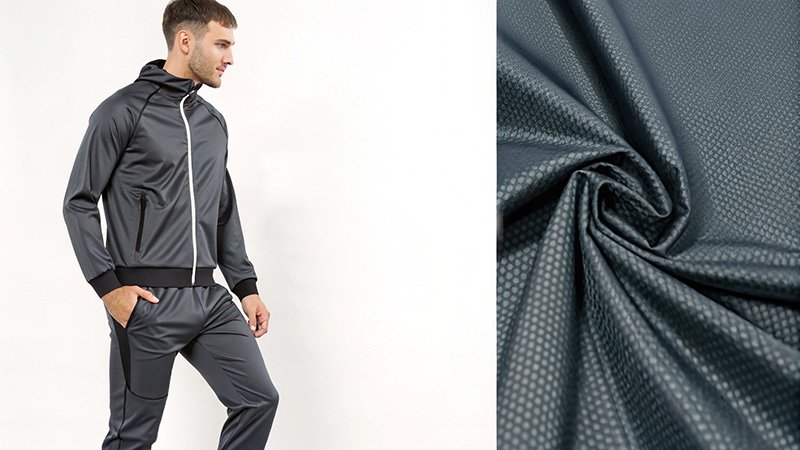
I've seen polyester evolve more than any other fabric. Years ago, it was a simple, cheap option. Today, it is the engine of the activewear industry. I worked with a performance brand that was skeptical about using 100% polyester. They remembered the heavy, non-breathable polyester of the past. I showed them a modern, micro-fiber polyester knit. It was incredibly soft, lighter than cotton, and when we tested it, it dried in a fraction of the time. They were completely convinced. The innovation isn't just in the fiber itself, but in how we knit it to create channels that actively pull moisture away from the body. It’s a true performance workhorse.
The Science of a High-Performance Synthetic
Modern polyester is engineered for athletes. Its properties are designed to enhance comfort during intense activity.
| Polyester Feature | How It Works | Benefit for the Wearer |
|---|---|---|
| Hydrophobic Nature | The fibers do not absorb water; they push it to the surface. | The fabric dries extremely quickly, preventing a cold, clammy feeling. |
| Superior Durability | It has strong, resilient fibers. | It resists stretching, shrinking, and pilling, making the garment last longer. |
| Color Fastness | It holds dye exceptionally well. | Bright, bold colors will not fade after many washes. |
| Recycled Polyester (rPET) | Polyester made from recycled plastic bottles. | Offers the same performance benefits with a much lower environmental impact. |
Exploring Nylon: What makes it a specialist for lightweight strength?
You need a fabric that can handle rough use but don't want a heavy, bulky tracksuit. Some durable materials can weigh a garment down. Nylon is the solution, offering incredible strength without the weight.
Nylon is a synthetic polymer known for its exceptional strength-to-weight ratio and abrasion resistance. This makes it perfect for lightweight yet durable tracksuits, especially windbreaker styles or reinforcement panels that need to endure friction.
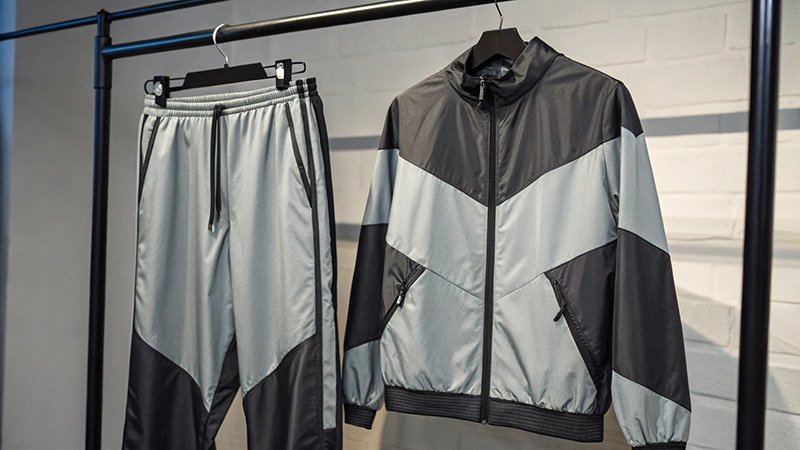
When a client asks me for a fabric that is "bulletproof," I often start by showing them nylon. Of all the common apparel fabrics, it is one of the toughest. It's the material used for things like parachutes and ropes for a reason. In tracksuits, we use it for lightweight shell jackets or pants that need to resist scuffs and scrapes. I recently sourced a ripstop nylon for a brand that creates apparel for trail runners. The fabric's special cross-hatch pattern prevents small tears from becoming big rips. This gives the runner confidence that their gear can handle contact with branches or rocks. Nylon provides that peace of mind.
The Resilient Lightweight
Nylon shines in specific applications where durability is the most important factor.
- Unmatched Toughness: Nylon has superior abrasion resistance compared to polyester. This makes it ideal for outerwear or for reinforcing high-wear areas like the knees and seat.
- Smooth and Silky Feel: It has a smoother, slicker hand-feel than most polyesters, which gives it a more premium feel in certain applications.
- Quick-Drying: Like polyester, it is hydrophobic and dries very quickly.
- Combination with Spandex: Blending nylon with spandex creates a fabric that is both incredibly tough and very stretchy, perfect for high-performance leggings or fitted jackets.
The Role of Spandex: How does it enhance flexibility and movement?
Does your tracksuit design feel stiff or restrictive during movement? A lack of stretch can ruin the function of an otherwise great design. Even a small amount of spandex can completely transform the fit and feel.
Spandex is a synthetic fiber known for its incredible elasticity. By blending just a small percentage (2-10%) into other fabrics, it allows the garment to stretch with the body and then snap back to its original shape.
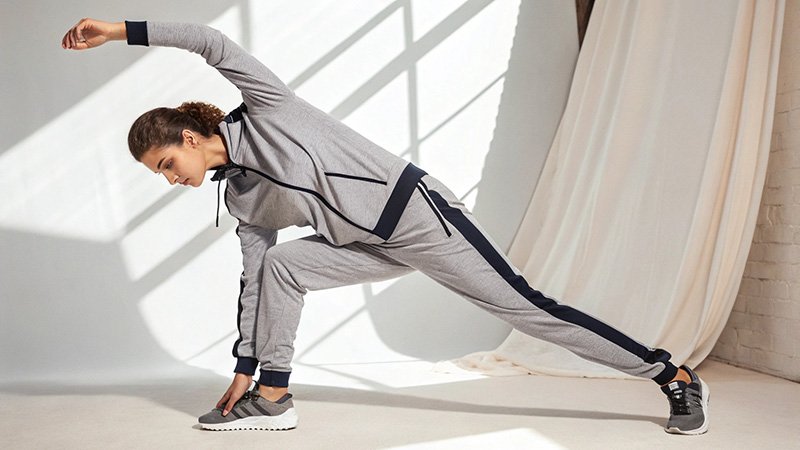
I always tell my clients that spandex is the most important supporting actor in activewear. It's almost never the star of the show; you'll rarely see a fabric made of 100% spandex. But its role is critical. Its job is to make every other fabric better. Think about the cuffs of a tracksuit jacket or the waistband of the pants. Without spandex, they would stretch out and look sloppy after a few wears. We recently created a fitted tracksuit for a dance-inspired brand. We used a cotton/polyester blend for softness and durability, but it was the 8% spandex that allowed for complete freedom of movement. It's the secret ingredient for comfort in motion.
The Magic of Elasticity
A little goes a long way. The percentage of spandex has a huge impact on the final garment's properties.
| Spandex Percentage | Common Use Case | Resulting Feel |
|---|---|---|
| 2-5% | Casual joggers, hoodies, relaxed-fit pants | Adds comfort, improves shape retention, prevents bagging |
| 5-10% | Athletic-fit tracksuits, standard leggings | Provides excellent freedom of movement for most activities |
| 10-25% | Compression leggings, high-support tops | Offers a tight, supportive "second-skin" fit |
Fleece Options: Are they only for insulation and warmth?
You're designing a tracksuit for cooler weather and need warmth. But you worry that warm fabrics are often heavy and not breathable. Modern fleece is the answer, delivering warmth without the weight or moisture issues.
While fleece is excellent for insulation, modern performance fleece is much more. Made from polyester, it is also lightweight, breathable, and moisture-wicking, making it a functional choice for active use in cold climates, not just for lounging.
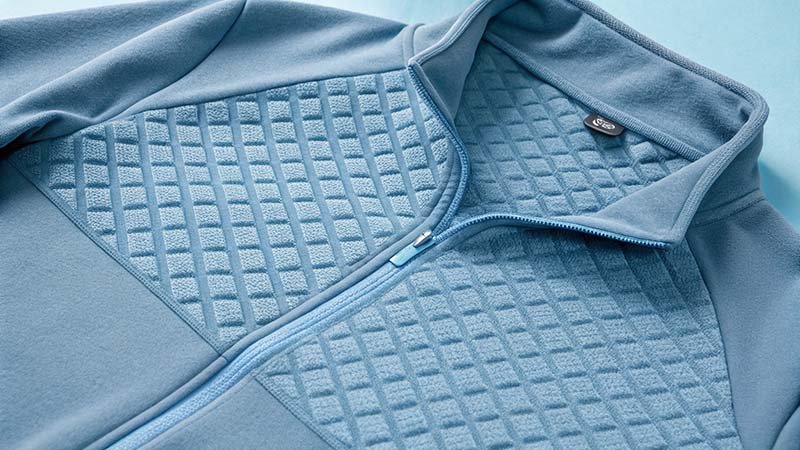
When people hear "fleece," they often picture a thick, heavy blanket. But in my studio, we work with a huge range of fleece fabrics. The key innovation was making fleece out of polyester. This simple change made it a true performance material. I remember a client who wanted to create a tracksuit for winter training. We selected a mid-weight grid fleece. The inside of the fabric had a pattern of small squares. The raised squares provided warmth, while the channels between them allowed moisture to escape. The final product was warm but never stuffy. It proved that you don't have to sacrifice breathability for warmth.
More Than Just Warmth
Fleece is a surprisingly technical fabric with different styles for different needs.
- How It Works: Fleece fabric has a napped or brushed surface. The process of brushing the fabric pulls up fibers to create a deep, soft pile. This pile traps tiny pockets of air, which is what provides the insulation.
- Types of Fleece:
- Microfleece: Very lightweight and highly breathable, perfect as a layering piece.
- Polar Fleece: The standard mid-weight fleece. It offers a great balance of warmth and low weight.
- Bonded Fleece: A fleece fabric with a smooth outer surface, often providing wind or water resistance.
Sustainable Choices: What about bamboo and other eco-friendly alternatives?
Your customers are asking for sustainable options, but you're not sure which ones perform well. You fear that "eco-friendly" might mean lower quality. The good news is that sustainable fabrics are now top performers.
Eco-friendly choices like recycled polyester, Tencel™, and bamboo viscose offer excellent technical performance. They provide softness, moisture management, and durability while meeting the growing consumer demand for environmentally responsible products.
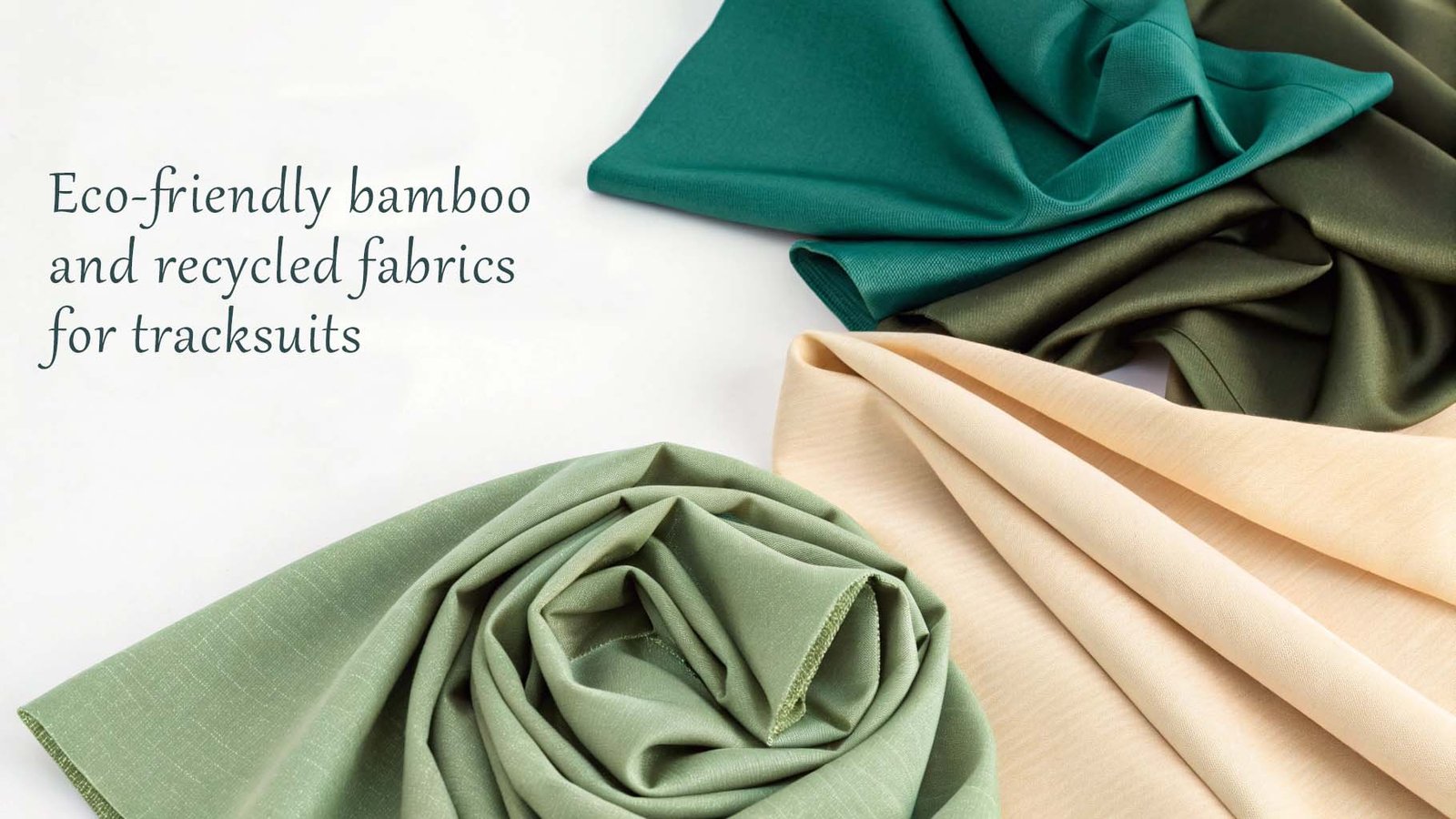
This topic is very important to me and to the future of our industry. Years ago, sustainable options were limited and expensive. Today, some of the most innovative fabrics we work with are also the most eco-friendly. Brands owned by people like Alex are built on modern values, and sustainability is at the top of the list. We now produce entire collections from GRS-certified recycled polyester, turning plastic bottle waste into high-performance tracksuits. We also work with closed-loop fibers like Tencel™, which are made from sustainable wood pulp. Choosing a sustainable fabric is no longer a compromise; it's an upgrade and a powerful way to tell your brand's story.
Performance with a Conscience
Choosing sustainable materials is a smart business decision that aligns your brand with modern consumer values.
| Sustainable Fabric | Source | Key Benefits |
|---|---|---|
| Recycled Polyester (rPET) | Recycled plastic bottles | Same performance as virgin polyester with lower carbon footprint. |
| Recycled Nylon | Post-industrial waste, fishing nets | Same durability as virgin nylon, helps clean up oceans. |
| Tencel™ Lyocell | Sustainably sourced wood pulp | Incredibly soft, breathable, and biodegradable. |
| Bamboo Viscose | Bamboo pulp | Very soft hand-feel, naturally breathable, but uses chemicals in processing. |
Mesh Integration: How does it optimize ventilation and airflow?
Your tracksuit design feels great, but it traps heat during a workout. Overheating is a major problem that ruins the user's experience. Strategic mesh panels are a simple and effective solution for ventilation.
Mesh is a fabric with an open, net-like knit. By placing mesh panels in high-sweat zones like the back, underarms, or along the legs, you allow heat and moisture to escape, dramatically improving airflow and keeping the wearer cool.
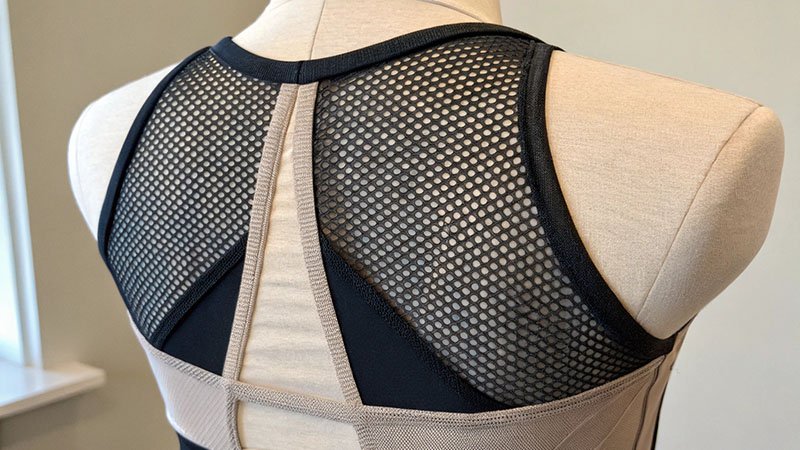
A great tracksuit is not always made from a single fabric. Sometimes, the smartest details are the ones you can barely see. From a manufacturing perspective, adding mesh panels is a sign of a thoughtful, high-quality design. It shows that the designer understands how the body works. We often use body-mapping data to guide our placements. For a running jacket, we might place a large mesh panel right down the center of the back. For tracksuit bottoms, a strip of mesh behind the knee allows for both ventilation and flexibility. It's a small detail that makes a huge difference in comfort, and it's a technique we use to elevate a standard design into a true performance garment.
The Power of Ventilation
Using mesh is about engineering breathability exactly where it's needed most.
- Pocket Linings: Using mesh for pocket bags reduces bulk and adds a bit of ventilation.
- Jacket and Hood Linings: A full mesh lining in a windbreaker shell allows the outer fabric to move freely over your inner layers and helps circulate air.
- Strategic Panels: This is the most common use. It involves cutting away the main body fabric in key areas and sewing in a panel of mesh. This provides direct ventilation to the skin.
Combining Fabrics: How do you achieve the ideal balance for performance and style?
You know that no single fabric is perfect for every need. Using just one material for an entire tracksuit is always a compromise. The best solution is to combine fabrics strategically to create a superior garment.
The ideal balance is achieved through "body-mapping" or "zonal construction." This means using different fabrics in different areas: durable materials on high-wear zones, stretch fabrics where movement is key, and breathable panels in high-heat areas.
This is where true craftsmanship comes into play. The most advanced tracksuits we produce are like puzzles, with each piece chosen for a specific reason. This is my favorite kind of work. We might build a tracksuit jacket using three or four different fabrics. The shoulders could be a durable, waterproof nylon to protect from rain. The front and back panels might be a soft, insulating fleece for warmth. The side panels could be a highly elastic spandex blend to allow for total freedom of movement. This approach costs more and is more complex to sew, but the result is a garment that performs perfectly in every way. It's the ultimate expression of function and style.
The Hybrid Approach
This is the cutting edge of tracksuit design, creating a single garment that is optimized for everything.
Example: A High-Performance Tracksuit Jacket
- Shoulders & Hood: A durable, water-resistant Nylon Taffeta to block wind and light rain.
- Front Body Panel: A lightweight, insulated polyester to keep the core warm.
- Side Panels & Underarms: A highly breathable and stretchy polyester/spandex blend to allow for movement and ventilation.
- Back Panel: Power mesh or a lightweight knit for maximum heat release.
Conclusion
Choosing the best tracksuit fabric means matching the material to your customer's needs. Blending fabrics for comfort, performance, and durability is the key to creating a product they will truly value.
.png)
